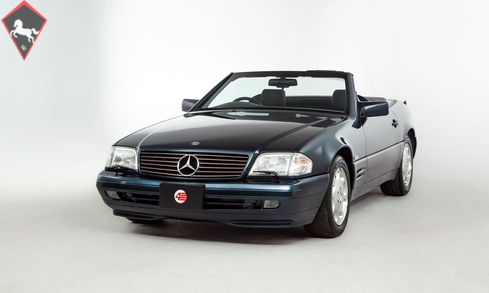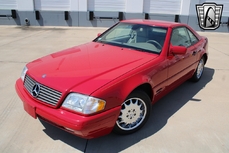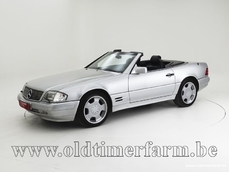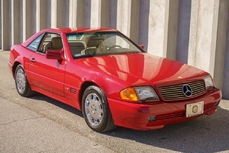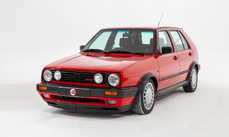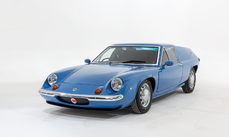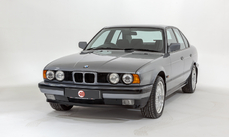Mercedes-Benz 500SL r129 1995
General description :
Model History
Designed and built as a grand tourer the SL was first introduced in 1954. The designation SL derives from the German "Sport Lightweight" and was first applied to the 300SL Gullwing. The SL model range is still in production today and has spanned five generations of models from 1954 to the present day.
The R129, as featured here, is the fourth generation of SL and was built from 1989-2002. Featuring a shorter wheelbase and updated rear suspension over its predecessor, the R107, the R129 was quick to introduce model updates and featured a large amount of styling, mechanical, and technological updates over its 12 year life span.
The R129 shot to the public's attention in 1991 when Diana, Princess of Wales sold her Jaguar to purchase a 500SL. This sparked a media storm as this was the first time a member of the royal family had chosen a foreign car. The media questioned whether British royalty should be driving foreign cars and eventually due to pressure she was forced to return the car to Mercedes-Benz in 1992. The car now features in the Mercedes-Benz Museum.
Some of the cosmetic and mechanical updates for 1995 cars included more modern rounded rents in the front wings, body coloured bumpers, side airbags, and a new five-speed transmission for the V8 and V12 models. The design of the steering wheel, seats, and gear selector knob were also updated.
Equipment
Green Black Metallic paintwork (189), Black leather upholstery (261), 5-speed automatic transmission, 8-hole alloy wheels (652), Removable hardtop, Electrically operated soft-top in black (740), Electric-folding door mirrors, Heated and electrically adjustable front seats with memory (241/242/873), Self-dimming rear view mirror (249), Leather steering wheel and gear selector, Mercedes cassette radio (253), Bose speaker system (810), Mercedes CD changer with remote, Cassette storage, Headlamp washer system (600), Heated driver’s door mirror (501), Mercedes first aid kid, R129 tool roll, Warning triangle, Remote central locking, Tailored overmats, Spare key.
Exterior
This V8 SL is beautifully presented in rare Green Black Metallic, a lovely colour that can appear very dark blue or green depending on the light. Looking closely the paintwork shows very few signs of age with a deep gloss to all panels. Better still the underside of this example maintains an immaculate finish free from any signs of corrosion or rust. The removable aluminium hardtop is also pristine and the electric folding soft-top operates smoothly at the touch of a button; the black fabric remains in excellent unworn condition and there is no damage to the rear window.
Interior
The unspoiled cabin boasts a glossy walnut centre console, with supple black leather extending from the seats to the door cards and gear selector knob. As a 1995 “minor facelift” R129 the interior boasts an updated steering wheel and later-style seats, which are heated and electrically adjustable with memory settings for both the driver and passenger. On close inspection all the switchgear and trim is still looking really fresh; even the spectacle box operates without fault. The seats are amazingly unworn and the footwell carpets are well protected by the dealer-supplied overmats. Pleasingly there are no aftermarket items to note; the original cassette radio remains in place along with the Mercedes CD changer, remote control, and Bose speaker system with subwoofer. Lifting the boot carpet you’ll find an unused alloy spare wheel and the R129 tool roll still packaged in its factory wrap.
ENGINE & TRANSMISSION
The Mercedes 5-litre V8 is a perfect complement to the R129. With effortless power delivery and a smooth auto ‘box, the SL500 is a capable long distance cruiser that’s equally suited to daily use. Barely run-in with a mere 24k miles the engine of this example remains in fine fettle having just been serviced and inspected at the current mileage. This one is also equipped with the uprated five-speed transmission (previously a hydraulic four-speed) that operates smoothly even by modern standards.
WHEELS, TYRES & BRAKES
The factory 8-hole alloys look great and still retain their original polished finish. Looking closely you will find some light curb marking but nothing untoward for the age; in the boot the spare is like new. All five wheels are wrapped in Michelin tyres, each with ample tread remaining. Following inspection the brakes have plenty of life left and perform well on test.
History File
The SL was first registered in December 1995. Originally supplied to Japan it remains in outstanding rust-free condition throughout, a real testament to the salt-free roads on which it resided from new. The car has only recently been imported by 4 Star with all taxes paid on arrival. It is now freshly serviced and fully UK registered with an MOT until February 2020. The original Mercedes document pack is present in the History File along with the owners’ manual and radio handbook.
http://www.4starclassics.com/for-sale/mercedes-r129-sl500-for-sale/
1995 Mercedes-Benz 500SL r129 is listed sold on ClassicDigest in Kingsley by 4 Star Classics for £17995.
Car Facts
Car type : Car Make : Mercedes-Benz Model : 500SL r129 Engine size : 5.0 Model Year : 1995 Sub type : Convertible Location : Hampshire
Sold
Seller Information
Sold
People who viewed this Mercedes-Benz 500SL r129 also viewed similar Mercedes-Benz listed at ClassicDigest
Other cars listed for sale by this dealer
About Mercedes-Benz
In the annals of automotive history, the journey of Mercedes-Benz is a tale that unfolds with the ingenuity of its founding pioneers. In the year 1886, Karl Benz crafted the Benz Patent Motorwagen, a creation that would go down in history as the world's inaugural automobile. Unbeknownst to him, this moment marked the genesis of what would evolve into the most illustrious premium car manufacturer globally. The financial underpinning of this pioneering venture, interestingly, was provided by Karl Benz's wife, Bertha Benz, demonstrating a remarkable partnership that would set the tone for Mercedes-Benz's legacy.A parallel narrative emerged not far away, as Daimler-Motoren-Gesellschaft, founded by Gottlieb Daimler and Wilhelm Maybach, entered the scene. In 1901, they unveiled their automobile under the now-famous moniker "Mercedes," meaning "godsend" in Spanish. This name was bestowed upon the car at the behest of Emil Jellinek's daughter, the distributor for Daimler-Motoren-Gesellschaft. The wheels of innovation were set in motion.
Fast forward to 1926, a pivotal year that witnessed the merger of Daimler with Benz & Cie., culminating in the birth of Daimler-Benz. The amalgamation saw the adoption of "Mercedes-Benz" as the distinguished trademark for their automobiles, fusing the legacies of two visionary entities into one.
Contrary to perceptions of conservatism, the trajectory of Daimler-Benz unfolds as a chronicle of industry firsts. From the introduction of the honeycomb radiator to the float carburetor, and the pioneering implementation of four-wheel brakes in 1924, Daimler-Benz consistently pushed the boundaries of automotive innovation. The diesel-powered Mercedes-Benz 260 D in 1936 marked the inception of diesel engines in passenger cars. The iconic Mercedes-Benz 300SL Gullwing made history as the first car with direct fuel injection, albeit the Gutbrod's tiny 2-stroke engine can claim precedence.
Safety innovations became a hallmark, with Béla Barényi's patented safety cell design in the "Ponton"-models in 1951, featuring front and rear crumple zones. The W116 450SEL 6.9 saw the introduction of the Anti-Lock Brake system (ABS), another pioneering safety feature. From the first production airbags and beyond, the legacy of "firsts" continued to be etched into the fabric of Daimler-Benz.
Over its centennial journey, Mercedes-Benz has not merely produced cars but has sculpted automotive icons. The SSKL, 710 SSK Trossi Roadster, 770K Grosser, 540K Spezial Roadster, 300SL Gullwing, w100 600 Pullman, w111 280SE 3.5 Flachkühler, w113 230SL Pagoda, w109 300 SEL 6.3, and w201 2.3-16 Cosworth stand testament to the brand's commitment to engineering excellence.
The roaring Silver Arrows, or "Silberpfeile," including the W 25, W 125, W154, W165, and W196, created a legacy of dominance on the racetrack. These machines were not merely cars; they were expressions of precision, speed, and an indomitable spirit that left their competitors in the dust.
As Mercedes-Benz marches into the future, it does so not just as an automaker but as a custodian of a legacy, a torchbearer of innovation, and a beacon of automotive excellence. The road ahead is sure to witness the continued fusion of cutting-edge technology, timeless design, and an unwavering commitment to setting new standards in the world of automobiles.
One luminary figure who left an indelible mark was Béla Barényi, often heralded as the "father of passive safety" for his pioneering work in safety engineering. His patented safety cell design, featuring front and rear crumple zones, became a hallmark of Mercedes-Benz's commitment to occupant safety, setting new standards that reverberated throughout the automotive world.
Moving through the chronicles, the collaborative genius of Wilhelm Maybach, alongside Gottlieb Daimler, laid the foundation for Daimler-Motoren-Gesellschaft. Their innovations not only birthed the first Mercedes but established a culture of relentless pursuit of technological excellence that remains integral to Mercedes-Benz's DNA.
In the post-merger era of 1926, Ferdinand Porsche emerged as a prominent figure within Mercedes-Benz. His work on the Mercedes-Benz S-Type, a supercharged race car, garnered acclaim and set the stage for a legacy that extended far beyond the marque. Porsche's impact would later extend to his eponymous company, but his influence at Mercedes-Benz during those formative years was pivotal.
As the 20th century progressed, the legendary Rudolf Uhlenhaut emerged as a key figure. Uhlenhaut, an accomplished engineer and the driving force behind the iconic Silver Arrows, played a crucial role in Mercedes-Benz's dominance in motorsports. His engineering prowess and attention to detail were instrumental in creating some of the most formidable racing cars of the era.
In the latter half of the century, figures like Bruno Sacco, the head of design at Mercedes-Benz from 1975 to 1999, left an indelible imprint on the brand's aesthetic identity. Sacco's design philosophy, characterized by clean lines and timeless elegance, shaped iconic models like the W126 S-Class and the W201 190E, solidifying Mercedes-Benz's reputation for luxury and sophistication.
The narrative would be incomplete without acknowledging the contributions of engineers like Hans Scherenberg, whose leadership in the 1970s ushered in a new era of technological innovation at Mercedes-Benz. Scherenberg's tenure saw the development of groundbreaking technologies, including the Anti-Lock Brake system (ABS) and the introduction of airbags in production cars.
